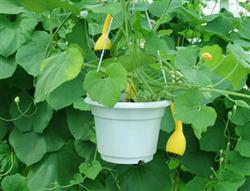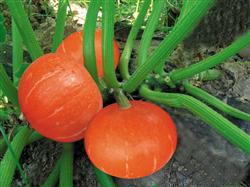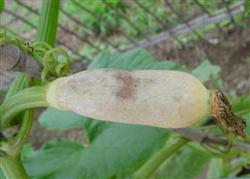How to plant ornamental pumpkins?

How to plant ornamental pumpkins? Please introduce the planting method to grow ornamental pumpkin can refer to the following methods: 1. Ornamental characteristics of commonly used varieties (1) Dragon and Phoenix ladle spoon-shaped small fruit, the bottom of the fruit is spherical, the top has a long handle. The fruit is dark green at the bottom and orange at the top, with light yellow stripes. (2) Yuanyang pear pear-shaped small fruit with dark green at the bottom and golden yellow at the top, all with light yellow stripes. (3) the large fruit of Dabingdan is a traditional "8" shape, the upper and lower ends are spherical, and the connection is fine. two。 Main points of cultivation techniques (1) during the sowing period, the open field in South China is planted in spring and autumn, usually sowing from January to February in spring and from July to August in autumn. Greenhouses can be planted year-round. (2) selection of nursery bed and preparation of seedling soil can protect seedlings from cold and heat preservation in greenhouse in early spring, and cover sunshade net in autumn to prevent rain and cool down. An anti-insect net is used around the greenhouse to prevent the invasion of diseases and insect pests. The nutrient soil was prepared with 6 parts of peat soil, 3 parts of river sand and 1 part of perlite, mixed with 1 kg compound fertilizer (N 15 ∶ P 15 ∶ K 15). The seedlings were raised in plastic seedling cups of 8 cm × 8 cm. (3) before sowing, the seeds were wrapped in towels and soaked in 30 ℃ warm water for 3 hours, then germinated in a 30 ℃ incubator and sowed after exposure to white. Sow the seedling soil with water the day before sowing, sow 1 grain per cup, then cover the nutritive soil with a thickness of 0.8 cm, then cover it with a sunshade net, and remove the sunshade net in time after the cotyledons are unearthed. In the process of raising seedlings, attention should be paid to maintaining a suitable temperature and soil moisture. Generally, the temperature in the greenhouse in early spring should be about 25 ℃. The seedling soil should not be too wet and too dry to avoid diseases. It can be sprayed with 500-fold diexamethasone solution or 800-fold carbendazim solution to prevent quenching disease. When the seedling growth is weak or the leaf color turns yellow, 2% compound fertilizer can be sprayed once or twice, and it can be planted when the seedling has 4 or 5 true leaves. (4) 1000 kg of rotten chicken manure and 30 kg of compound fertilizer were applied per mu. The surface of the planting field should be flat, fasten the greenhouse film 10 days before planting, and sterilize and kill insects in the greenhouse with high temperature. Pumpkin is a trailing plant, ornamental pumpkin is mostly cultivated in scaffolding, the density should not be too large, generally planting about 1200 plants per mu. Choose sunny day in the evening to plant, spray water half a day before planting, remove the plastic seedling cup during planting, pay attention to keep the seedling soil intact, spray enough fixed root water after planting, and cover the sunshade net on the roof in summer to prevent the young seedlings from dying in the hot sun. (5) Field management 1) moisture. The new seedlings after planting should pay special attention to water management, spray water in the morning and evening and keep moist; ornamental pumpkin needs less water in the early stage of growth, and can spray water once a day after slowing down seedlings to keep the soil moist; if the weather is wet, it can be sprayed once every two days; more water is needed in the peak growth period and flowering and fruiting period, so it is necessary to ensure water supply; spray water 2 times a day in summer when the sun is fierce and the air is dry. 2) temperature management. Ornamental pumpkin is a temperature-loving crop, and the suitable growth temperature is about 25 ℃. It is required that the temperature in the greenhouse should be controlled at 15 ℃ ~ 30 ℃, and the greenhouse film should be covered when it is lower than 15 ℃ to avoid frostbite. When the temperature is higher than 30 ℃, remove the greenhouse film to strengthen ventilation, and cover the roof with sunshade net to cool down. 3) fertilizer management. Seven days after planting, the roots were sprayed with 3% compound fertilizer solution; the germinated new roots were sprayed with 3% compound fertilizer water once a week before vine flowering to make the plant grow healthily. Water and fertilizer should be controlled from flowering to long melon. Generally, after sitting on 2 or 3 melons, 50 kg of organic fertilizer and 20 kg of compound fertilizer are applied per mu to promote the expansion of young melons. The method is 25 cm away from the base of the stem or strip application, be careful not to be too close to the base of the stem, otherwise it is easy to cause root burning, spray water after application. Fertilizer was applied once more in full melon stage and harvest period according to the situation of sitting melon and the change of leaf color, and the method was the same as mentioned above. In addition, it can also be sprayed with 1000-1200 times plant power liquid 2000 to improve the melon setting rate. 4) pruning the vines. When the height of the seedling is 25cm to 30cm, use a bamboo pole or rope to guide it to grow upward. There are more lateral vines in the process of pumpkin growth, but ornamental pumpkins are mainly main vines, so the lateral vines below 1 meter should be removed in time so as not to consume nutrients and affect flowering and fruiting. After the main vine is put on the scaffolding, one or two more side vines can be left to increase the number of melons. The lateral branches that affect the plant shape should be cut off to make the plant compact and ornamental. 5) artificial pollination. Pollination began at 09:30 in the morning. Select the male flowers that bloomed that day. After removing the Corolla, the pollen of stamens was sprinkled on the stigma of the female flowers. If pollination is too early, the pollen is not dispersed; if pollination is too late, the pollen will lose its vitality, which will affect the melon setting rate. 6) Control of diseases and insect pests. Ornamental pumpkin is susceptible to powdery mildew, virus disease, Fusarium wilt, and vulnerable to aphids and mites. It can be used to control powdery mildew with 800x dimethoate + 800x carbendazim solution or 600x trimethoprim solution, spray to control aphids with 1000 times of 40% dimethoate EC or 1000 times of thistle aphid liquid, control mites with 800x solution of anti-mites, and prevent virus disease with 500x solution of 20% virus A500. When spraying, the leaves should be evenly sprayed on the positive and negative sides to improve the control effect. 7) harvesting. The main way to watch pumpkins is to watch or make works of art. generally, they should be harvested when the melon is fully ripe and the peel hardens. If it is used for food, it can be harvested about 20 days after flowering, before the peel is hardened, and can be picked with a handle with scissors. Click to get more pumpkin planting techniques click to get more vegetable planting techniques
- Prev

How to plant and manage red chestnut pumpkin?
How to plant and manage red chestnut pumpkin? Please introduce the method that red chestnut pumpkin can be planted and eaten, adjust the diversity of varieties in the vegetable market, and can also be cultivated as ornamental and green plants in the main places. The reference of cultivation method is as follows: 1 Red chestnut pumpkin characteristic young melon is light yellow and white, with melon age.
- Next

How to prevent pumpkins from turning into melons?
How to prevent pumpkins from turning into melons? Please introduce the pumpkin causes and control methods can refer to the following: (1) the main symptoms grow to a certain size of young melons stop growing, gradually yellowed and atrophied, and finally withered or shedded. (2) the cause of the disease is pollen dysplasia and low temperature in early spring in greenhouse.
Related
- Where is it suitable to grow horseradish in China? it is expected to see the middle altitude horseradish in Alishan.
- How to prevent tomato virus disease reasonably? (Control methods included)
- Many people like to plant towel gourd on the balcony. What are the main points of this method and management?
- What crops can chili peppers be mixed with?
- Fertilization techniques and matters needing attention in Tomato
- What are the grafting techniques for peach seedlings in spring?
- Harm and control methods of root swelling disease of Chinese cabbage
- What are the pests of sweet potatoes? How to prevent and cure it?
- Symptoms, causes and Control methods of navel Rot in Tomato
- The cause of "Cucumber rotten bibcock" in Farmers' planting Cucumber and its Control Plan

